
- English
- Español
- Português
- русский
- Français
- 日本語
- Deutsch
- tiếng Việt
- Italiano
- Nederlands
- ภาษาไทย
- Polski
- 한국어
- Svenska
- magyar
- Malay
- বাংলা ভাষার
- Dansk
- Suomi
- हिन्दी
- Pilipino
- Türkçe
- Gaeilge
- العربية
- Indonesia
- Norsk
- تمل
- český
- ελληνικά
- український
- Javanese
- فارسی
- தமிழ்
- తెలుగు
- नेपाली
- Burmese
- български
- ລາວ
- Latine
- Қазақша
- Euskal
- Azərbaycan
- Slovenský jazyk
- Македонски
- Lietuvos
- Eesti Keel
- Română
- Slovenski
- मराठी
- Srpski језик
What is Industrial Linear Lighting and How Does It Work in Commercial Spaces
2025-07-22
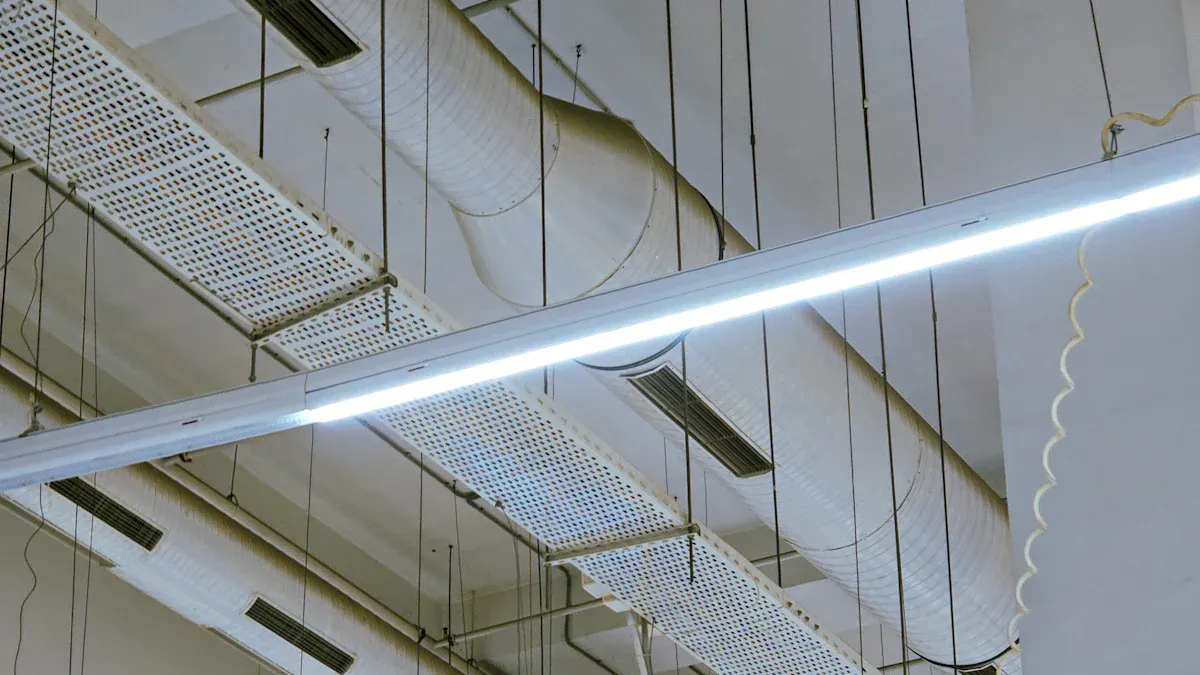
Industrial linear lighting is also called industrial strip lights. It gives bright and even light to big spaces. This lighting is used a lot in commercial and industrial places. LED fixtures make up 60% of linear lights. They also account for 75% of sales. Linear lighting works well in many places because it is flexible and looks nice. It saves energy and works well for a long time. It has a modern look that fits offices, warehouses, and stores. People also call these lights recessed, surface-mounted, or suspended lights.
Key Takeaways
- Industrial linear lighting uses long LED fixtures to give bright light. It lights up big places like offices, warehouses, and stores.
- LED linear lights use less energy and last a long time. They help businesses save money and lower maintenance costs. They are also better for the environment.
- These lights spread light evenly and cut down on glare and shadows. This makes work and shopping safer and more comfortable for everyone.
- There are three main types of linear lighting. They are recessed, surface-mounted, and suspended. Each type works best in different spaces and styles.
- Smart controls and dimming options help businesses change the lighting easily. This saves energy and makes the space feel right for work or shopping.
Industrial Linear Lighting
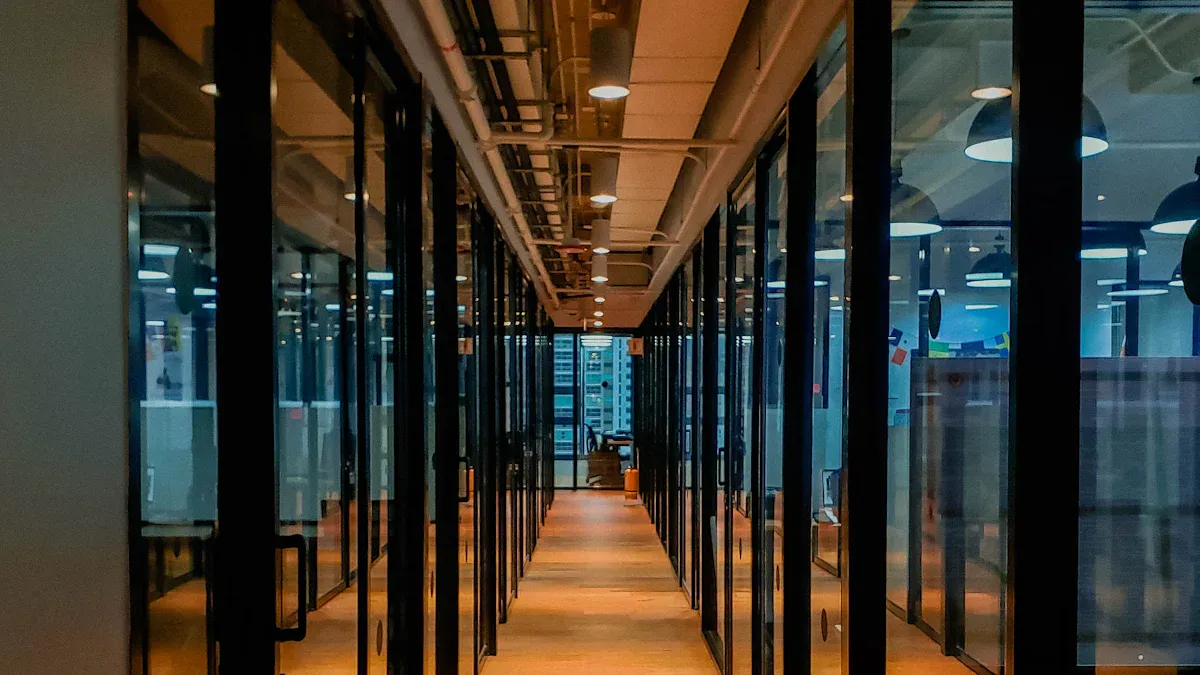
Definition
Industrial linear lighting is a kind of lighting system. It uses long, thin fixtures to light up big areas. These are also called industrial strip lights. They use advanced led technology for steady light. This lighting works well in tough places like factories and stores. Warehouses and big shops use linear lighting to cover large spaces. It helps keep shadows low. In the last ten years, many buildings switched from fluorescent to led linear lighting. This happened because led lights save more energy. They also cost less to keep up and work better.
Key Features
Industrial linear lighting has many features that make it a good choice for businesses.
- Built to last in tough places, so it is strong and works well.
- Special design spreads light evenly and cuts down on glare. This makes it easier to see.
- Uses less energy, which helps save power and is better for the planet.
- Lasts a long time, so you do not have to replace it often. This means lower maintenance costs.
- You can install it in different ways, like on the surface, inside the ceiling, or hanging down. This lets you be creative with how it looks.
- You can change how bright it is and the color of the light. This helps match the lighting to different jobs and spaces.
- You can connect many fixtures together for more light and flexible setups.
- Made from materials that can be recycled, which is good for the environment.
- Can be dimmed and works with smart controls like motion sensors and dimmers.
- Has a simple, modern look that fits new buildings.
More companies are choosing industrial linear lighting because of its benefits. LEDs now use about half the energy of old lights. This helps businesses save money and follow rules. It also makes places safer and better for work.
How LED Linear Lighting Works
Components
LED linear lighting uses special parts to give bright light in big places. Every part helps the lights work well and last longer. The table below shows the main parts and what they do:
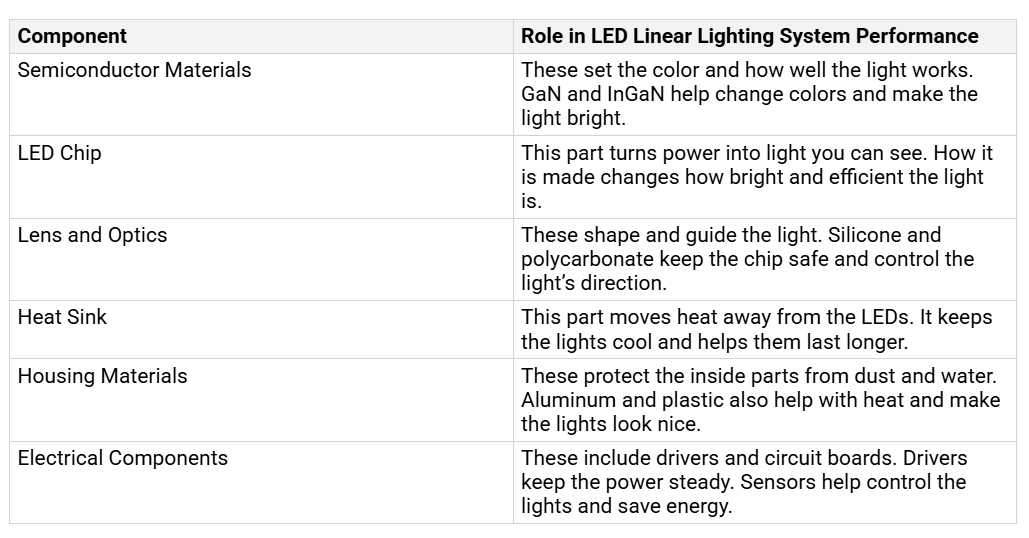
Tip: Good parts in led linear lighting help the lights work well, last long, and need less fixing.
Installation
There are different ways to put up led linear lighting in commercial spaces. Each way works for different needs and looks. Here are the most common ways:
- Recessed Mounting: Installers put the led linear lights inside ceilings or walls. This makes the space look neat and modern. Offices and stores use this for general or work lighting.
- Pendant Mounting: The lights hang down from the ceiling on cables or rods. This works well over tables, counters, or long work areas. It looks nice and is useful.
- Surface Mounting: Installers attach the led linear lighting right onto ceilings or walls. This way is flexible and fits many types of buildings.
These ways let led linear lighting be the main light or just add extra light. People can pick how bright the lights are, the color, and the finish. The best way depends on the room, ceiling, and style wanted.
Note: Picking good led lighting and having skilled installers helps the job go well and the lights work their best.
LED technology saves energy, so these lights are a smart pick for businesses. When installed right and made with good parts, led linear lights give strong, long-lasting light in any business space.
Benefits of Linear Lighting
Energy Efficiency
Linear lighting is very good at saving energy in big buildings. LED linear fixtures use much less power than old lights. They use up to 75% less energy than incandescent and halogen lights. LEDs also beat fluorescent lights by using less electricity and lasting longer. LEDs turn more power into light and waste less as heat. This helps lower bills and is better for the planet.
Lighting uses about 35% of all energy in commercial buildings. Switching to LED linear lighting can save up to 70% of that energy. Sometimes, LEDs use up to 90% less energy than old lights. This means you can use fewer lights or lower power and still get the same brightness. It also lowers power bills and puts less strain on the building’s wiring. LEDs make less heat, so the workplace is safer and needs less cooling.
If factories switch to LED linear lighting, they can save 60% to 80% on energy. These savings are big for places that stay open a long time.
LED linear lighting is also safer for the environment. It does not have dangerous stuff like mercury, which is in fluorescent lights. This makes LEDs a safer and greener choice for lighting.
Uniform Illumination
Linear lighting gives even light across big rooms. The design spreads light along the whole fixture. This stops glare and bright spots. It works well in offices, warehouses, and stores.
- Linear lighting spreads light evenly and cuts down on shadows.
- The long shape lets the light cover more space without gaps.
- You can put these lights in ceilings, hang them, or mount them for the best effect.
- Point-source lights can cause glare and need more fixtures, but linear lighting gives steady light with fewer lights.
LEDs in long, thin fixtures help give even light. This makes it easier on your eyes and helps you see better. In businesses, color accuracy is important. Industrial linear lighting usually has a CRI between 80 and 90. A CRI of 80 or more is good for most jobs. A CRI of 90 or more is best for places where color must be exact. Higher CRI means better color, more comfort, and safer work. This helps people do their jobs better.

Durability
Industrial linear lighting is very tough and lasts a long time. LED fixtures last much longer than other bulbs. Most industrial LED linear fixtures last 50,000 to 70,000 hours. Fluorescent bulbs last only 10,000 to 20,000 hours. Incandescent bulbs last less than 10,000 hours. This means you do not have to change them as often, which saves time and money.

- LED fixtures are strong and do not have glass parts that break easily.
- The tough build keeps them safe from bumps and hits in busy places.
- Fewer changes and fixes mean you spend less on work and parts.
- You can get to the parts quickly, so fixing them is easy and fast.
- Smart lighting lets you check and fix lights from far away, so you avoid big problems and keep lights working well.
To sum up, linear lighting saves energy, gives even light, and lasts a long time. These things help the planet, save money, and make work safer and better in big buildings.
Types of Linear Lighting
Linear lighting comes in a few main types. Each type works best for different places and needs. The three main types are surface-mounted, recessed, and suspended. Each one has its own good points for business spaces.
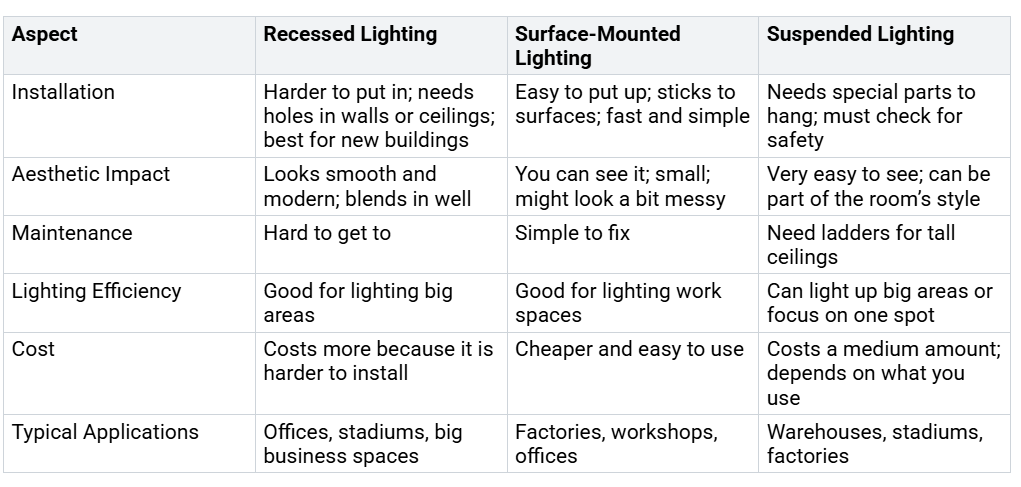
Surface-Mounted
Surface-mounted linear lighting goes right on ceilings or walls. This type is used a lot in businesses. In 2023, it made up over half the market. Many companies pick it because it is easy and cheap to put in. These lights give even light and work well in offices, workshops, and garages. It is easy to fix them because you can reach them. This type is best for places where you need fast and simple setup.
Tip: Surface-mounted linear lighting is great for rooms with concrete ceilings or where you move things around a lot.
Recessed
Recessed linear lighting fits inside ceilings, walls, or floors. Installers cut holes to put the lights in, so the room looks neat and modern. Offices and stores use this type for its clean look and to save space. In offices, these lights go in long rows to give even, soft light that helps people work. Stores use recessed lighting to show off products and make cool ceiling designs. This type can dim and use smart controls, so you can change the light easily.
Recessed lighting makes rooms look stylish and calm.
It is good for both main light and special spot lighting.
Suspended
Suspended linear lighting hangs from the ceiling with rods, wires, or chains. This type is best for rooms with high ceilings, like warehouses and stadiums. Designers use these lights to make fun shapes and add a modern feel. These lights can light up a whole room or just one area, depending on where you put them. Suspended lighting also helps split up big open rooms and lets you be creative with the design.
Suspended lights give even, soft light with less glare.
They help save energy and are good for green building designs.
Note: Pick the right linear lighting by thinking about ceiling height, how you use the room, and how you want it to look.
Applications in Commercial Spaces
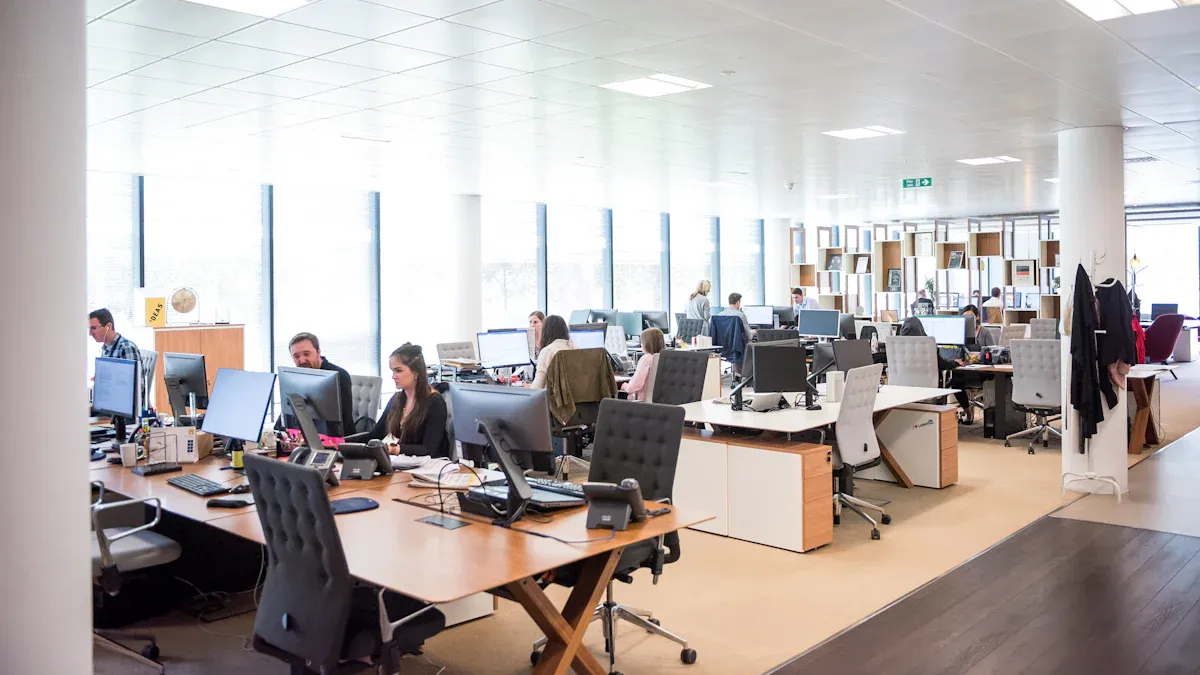
Offices
Modern offices use linear lighting to help people work better. Workers get even light that does not hurt their eyes. This stops glare and shadows, so eyes do not get tired. Linear lighting gives the right brightness and color for each job. Many offices have smart systems to change the lights. People can make lights brighter or dimmer as needed. These systems save energy and make the office more comfortable. Lights turn on and off fast and do not flicker. This helps people focus and not get headaches. Designers can put linear lighting in ceilings, walls, or furniture. This makes the office look nice and work well. Good lighting keeps people safe and helps them find exits in an emergency. Offices with smart lighting see happier and more productive workers.
Tip: Changing the light in work areas helps people stay awake and feel good all day.
Retail
Stores use linear lighting to show off products and make shopping fun. Bright, even light helps customers see everything clearly. There are no dark spots or harsh shadows. The table below shows how linear lighting helps stores:

Stores use smart controls to change lights during the day or when more people come in. This saves energy and keeps the store looking great. Good lighting helps guide shoppers and makes special products stand out.
Industrial Facilities
Factories and warehouses need bright, even light to keep workers safe. Linear lighting helps workers see well and avoid accidents. It cuts down on dark spots and shadows. Upgrading to LED linear lighting helps meet safety rules. It also makes it easier to handle emergencies. Smart controls like motion sensors turn lights on only when needed. This saves energy and keeps work areas bright. Good lighting helps workers feel less stressed and focus better.
Hospitality & Healthcare
Restaurants, hotels, and hospitals use linear lighting to make spaces feel nice. In restaurants, soft light helps guests relax and enjoy their meal. Hospitals use special lighting to help patients sleep and get better. People can change the lights to feel more comfortable. Soft, gentle light makes rooms calm and peaceful. Good lighting in lobbies and dining rooms makes guests happy. Staff in these places also work better with good lighting. Using less energy saves money and helps the planet.
Note: Smart controls in restaurants and hospitals let people change the lights to fit what they need or how they feel.
Industrial linear lighting has lots of good points for businesses.
- It helps keep people safe and lowers the chance of accidents. It also makes work areas nicer for everyone.
- LED systems use less energy, so power bills go down. These lights also help companies be kinder to the planet.
- New styles make spaces look better and work better too.
- More companies want these lights because they are smart and easy to use.
- Picking this lighting can help people work better and feel more comfortable.
FAQ
What is the main advantage of industrial linear lighting in commercial spaces?
Industrial linear lighting gives bright and even light in big rooms. This makes it easier for workers to see and stay safe. These lights use less energy and last longer, so businesses save money.
Can linear lighting work with smart building systems?
Yes, linear lighting can connect to smart controls. Managers use sensors, timers, or dimmers to change how bright the lights are. This saves energy and keeps the space comfortable.
How long do LED linear lights usually last?
Most LED linear lights work for 50,000 to 70,000 hours. They last a long time, so businesses do not need to replace them often.
Where can businesses install linear lighting?
Businesses can put linear lighting in offices, warehouses, stores, hotels, and hospitals. These lights go on ceilings, walls, or can hang down, so they fit many places.
Does linear lighting help improve workplace safety?
Yes. Linear lighting cuts down on shadows and dark spots. Workers can see dangers better, so accidents and injuries happen less.



